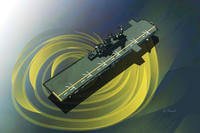The first littoral combat ships are set to deploy with mine countermeasures packages, including airborne systems and unmanned technology, by the end of the decade, Navy and Marine Corps officials said Wednesday.
One of the three missions the small surface ships are set to take on is mine countermeasures, replacing the Navy's aging fleet of Avenger-class mine countermeasures [MCM] ships. But they'll do the job using a new range of technologies, many of which are unmanned. This, officials said, will allow the Navy to "take the sailor out of the minefield" and complete longer missions with fewer resources.
The Coastal Battlefield Reconnaissance and Analysis (COBRA) system, a minehunting payload designed to operate aboard the MQ-8 Fire Scout unmanned aerial vehicle, is set to achieve initial operational capability by the end of September, said Marine Maj. Gen. Christopher Owens, director of the Navy's Expeditionary Warfare Division.
Two more airborne systems, the Airborne Laser Mine Detection System, and the Airborne Mine Neutralization System, achieved IOC at the end of November, Owens said. Both will operate aboard the Navy's MH-60S chopper to locate and take out sea mines from the air by means of powerful armor-piercing warheads.
All these systems are headed for shipboard testing later this year, along with the AQS-20A minehunting sonar, a system designed to be pulled by the Common Unmanned Surface Vehicle, a new surface drone boat now in water testing.
"These tests are going to allow us to finalize our initial package composition that will go aboard LCS for near-term deployments," Owens said. "Testing's also going to allow the sailors who work with these systems from end to end in realistic environments so they can help refine our [concept of operations] and our tactical integration."
Despite some setbacks in development, officials expect the full new mine-hunting package to be complete by the close of fiscal 2019.
Using unmanned systems, Owens said, will lead to a significantly more effective minehunting operation.
"It's a force protection aspect, certainly," he said. "But probably as important, or more so, from our mission standpoint, is that the unmanned systems don't have crew decks. They don't get fatigued after eight hours in the direct sun working a minehunting problem. We can do this reliably 24 hours a day, not affected by darkness, not affected by the heat … it gives us the ability to over time really expand our clearance rates."
-- Hope Hodge Seck can be reached at hope.seck@military.com. Follow her on Twitter at @HopeSeck.










